Since being launched in 2008, Shein has completely taken over the world of fast fashion. Especially in the first year of the pandemic when a lot of small businesses drowned, Shein was thriving and became the most-mentioned brand on social media platforms like TikTok. With the extremely low prices and bad quality clothes, Shein is actually one of the most harmful brands I’ve ever come across. The fashion industry is the second largest polluter in the world, and Shein is currently the biggest fast fashion retailer. They control 28% of the fast fashion market in the US alone. So you can imagine how big Shein’s contribution is to the pollution in the fashion industry. In this post, I’m listing 6 reasons we should all avoid shopping from this brand and I’m hoping it will inspire you to learn more about sustainable fashion and how to make more conscious shopping decisions.
Who is Shein and who is behind it
If you’re not familiar with Shein yet, here’s a little introduction. Shein (pronounced as ‘She-In’) is a fast fashion brand, based in South China. They offer really cheap clothes and accessories for women, men and kids. They really have just about everything and you can always find the newest trends for barely any money.
Shein was founded Chris Xu. He was born in the US and his nationality is Chinese. He has no background in fashion or design or anything similar. He worked as an SEO specialist. You would hope that fashion companies are started by talented designers, who have a love for fashion and just want to pour their heart and creativity into their own company, but no. These big companies are usually founded by business men, for the sole purpose of earning money. Shein’s products are designed by many designers from different countries who receive 30% commission from the design’s sales. This is why Shein offers such a wide variety of products and why they’re able to release new styles so frequently, because they have many different designers.
That’s enough of a backstory for now. Now let’s see what the problems are with this brand.
#1. They use harmful materials
One of the reasons Shein can offer such cheap clothes, is because they use a lot of synthetic fabrics like polyester and nylon. You can get rid of your fast fashion pieces after one season, but clothing made from polyester take 20 to 200 years to decompose. Throwing polyester things out just means removing them from your closet, but the clothing items will probably outlive you. The production of synthetic materials is also very harmful and a big reason we have to deal with climate change now. The CO2 emissions for 1000 kg polyester fibers is between 7,2 and 9,52 kg of CO2. Making a year’s worth of polyester is around 700 million tonnes of CO2 annually. That’s the same amount of CO2 as 180 coal-fired power plants. If we continue at this speed, these numbers could double by 2030. Carbon emissions are a big cause of global warming. The more CO2 is released, the more problems we’ll have and the more the earth becomes unlivable.
Even if we look at other materials like cotton, it’s not much better. The CO2 emissions of cotton are lower, but cotton requires a lot of water, around 9800 liters for 1 kg of cotton fibers. And yes, if they would start using more sustainable materials, the items will become more expensive. But that’s how it should be. It just costs money to make clothes that won’t be harmful for us in the long run. We can’t produce all these toxic materials and mess up the planet only so you can buy a new cheap top every week.
#2. Their prices are unrealistically low
By cutting down on workers wages, and using cheap and bad quality materials, Shein is able to offer ridiculously low prices. This is one of the reasons they blew up and became so successful. You can easily buy 10 clothing items for under €50/$50. These prices should only be acceptable for secondhand clothes.
Fast fashion brands like Shein are making you believe clothes don’t have a lot of value and that it only takes a little bit of money to produce a clothing item. That’s not true. A polyester dress will always have the same value, whether a brand asks €5 or €50, the value will always stay the same. The production costs the same, it takes the same amount of material and effort to make. So, if Shein sells you a €5 dress, it doesn’t necessarily mean the value is lower than a polyester dress from a high-end brand, it just means someone else is paying for your dress. If you don’t pay the full price for an item, the people in the production chain will. The workers in Asia who are involved in making your dress, pay the ultimate price. And eventually, we will all pay for all the plastic produced for Shein’s customers because plastic is destroying the world.
Low prices imply that clothes are disposable and only made to be worn once or a few times. It also encourages consumers to splurge and buy a lot more than they need. If a top is the same price as a coffee, why not just get a few tops? Maybe in a few different colours… Especially knowing the shipping might take a few weeks, so you want to make it worth the wait by placing a big order. Speaking of the shipping, the delivery fee is often more or just as expensive as one garment, so it wouldn’t even be beneficial to only buy one item. Reportedly, Shein offers free returns in some countries, but if you want to return one item, they just let you keep the item and refund you. Otherwise Shein has to pay for the shipping which is often the same price as the garment so it’s not worth it for them. Shein is handing out garments like they’re candy.
Check out this post to learn how clothes are made and how much it takes
#3. Their production speed is more than the planet can handle
Shein is a classic example of a fast fashion brand, as they are supposedly able to produce an item of clothing within a week. This includes all steps from the designing to the packaging. To give a comparison: for fast fashion brands like H&M and Zara, this reportedly takes 3 weeks. Shein is mostly popular with Gen Z. They are very active on social media and they’re very sensitive for trends. Shein knows this and is constantly tracking the trends and responding as quickly as possible.
According to several sources, Shein adds between 700 and 2000 new styles a day. They start by producing the styles in small numbers, between 50 and 100 pieces. The items that are popular and selling fast, are then mass-produced on a larger scale. Even if we take the smallest batch of 50 pieces for 700 styles, that’s still 35.000 pieces (!) of clothing made every single day. You can do the math for the bigger batch…
The constant addition of new styles every single day, and the bad quality of the clothes encourages consumers to keep coming back and buy new stuff. The clothes are made to be worn a few times and then replaced by new trendy pieces. They handle over 10.000 orders daily. The average consumer throws away 60% of their new clothes within 1 year. A research done by Public Eye showed that one of Shein’s many suppliers in China, produces 1,2 million articles of clothing a day. Shein’s clothes are made in thousands of factories. Just think about these numbers for a second. Think about the amount of materials that are brought into the world daily. Many materials that take hundreds of years to decay.
If you’re already convinced after just three reasons, you can start looking for eco-friendly brands near you here on this brand list!
#4. They exploit their workers
As I mentioned before, if you don’t pay the full price for an item, someone else will. The fashion industry is notorious for underpaying workers and having them work in dangerous and uncomfortable conditions. Only because brands want to offer their customers new clothes as often as possible for almost no money. The $5 top you want to buy from Shein, was most likely made by someone who works 12 hours a day, 7 days a week.
Many of Shein’s suppliers are small and informal factories that are often not very well regulated. In a report made by Public Eye in November 2021, they discovered some employees at Shein’s suppliers work 75-hour weeks. For this report, 17 factories were visited where they interviewed 10 workers in six cities in China. The employees they spoke to, worked three shifts per day: 4 hours in the morning, then they have 1,5 hour lunch break, a bit over 4 hours of work in the afternoon, and then a dinner break of a little over 1 hour, and an evening shift of another 3 to 3,5 hours. The evening shift is 6 days a week, and they only have one day off per month. A total of 75 hours a week… Before you start thinking this might just be normal in China, it’s not. According to the labour laws in China, a working week should not be more than 40 hours. Shein is ignoring these laws. According to the interviewed workers, they are not paid overtime and they all said they didn’t sign an employment contract. The workers don’t receive any social security contributions, and many factories don’t comply with basic safety standards. More violations of the Chinese labour law.
Shein workers are paid per item. So the more items they make, the more they get paid. This system encourages employees to work long hours, but this also means that if a garment doesn’t pass the quality check, they don’t get paid for it. Moreover, if there is no work available, they don’t have a salary, so it’s an insecure and unstable job for the workers. They never know how much money they’ll be able to take home each month. As Shein’s orders are often small batches of 50 or 200 pieces, workers constantly have to adjust to new designs. When they’re just getting used to sewing a certain garment, they have to switch to a new design again. It takes longer to sew a garment if you’re not familiar with it, but because they are paid per item, this is only at the expense of the workers.
This same research concludes that for a white and blue floral dress made from polyester, the seamstress/seamster is probably paid around 3 yuan (47 US cents). The dress is then sold by Shein for around €10/$11 USD.
#5. They use plagiarised and insensitive designs
As if exploitation and harming the planet isn’t already enough, it seems Shein can’t even do the first step (designing) in an ethical way. You would think the designing phase would be the least harmful step in a production chain where nothing can go wrong. Not for Shein. It’s really common in fast fashion that brands take inspiration from luxury and high-end brands. They are usually the ones that define the trends. Brands like Zara often have dupes of designer items. Most brands, however, just take inspiration from luxury brands and at least change up the designs a bit so they won’t be exactly the same. Shein doesn’t. They plagiarise and copy designs and don’t even bother to change things. But they don’t steal from big name brands, they scour the internet for small brands, designers, and artists and take the designs they probably worked on for months and sell them for almost no money. Below are just a few examples but there are many more designers and artists that got robbed by Shein.
UPDATE
I decided to do some more research on all the designers and artists that had a design copied by Shein. Check out the full list here: 30+ Businesses Shein Stole Designs From.
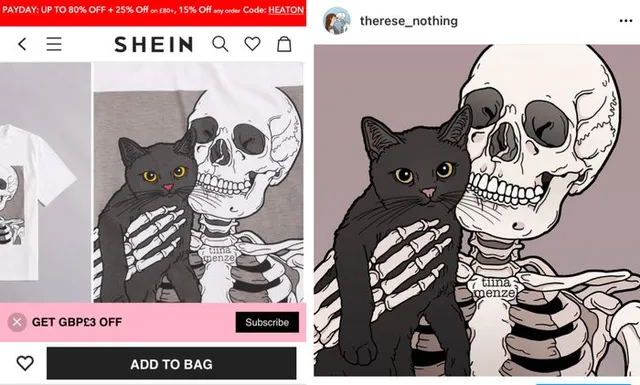
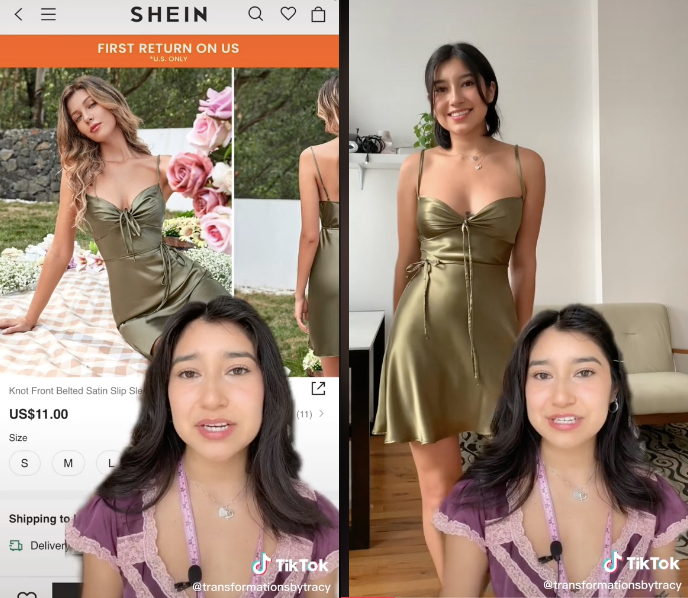

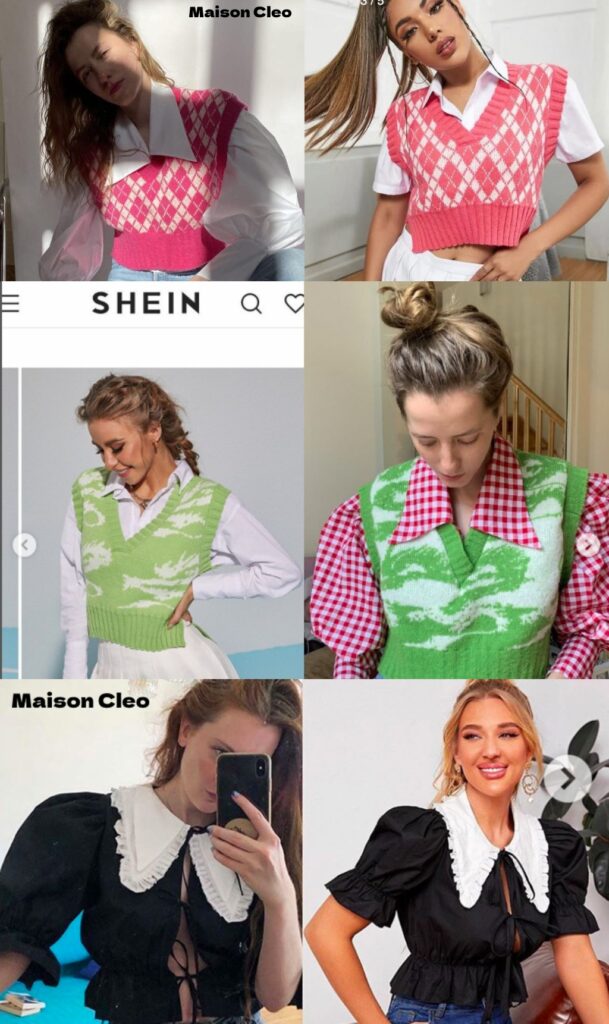
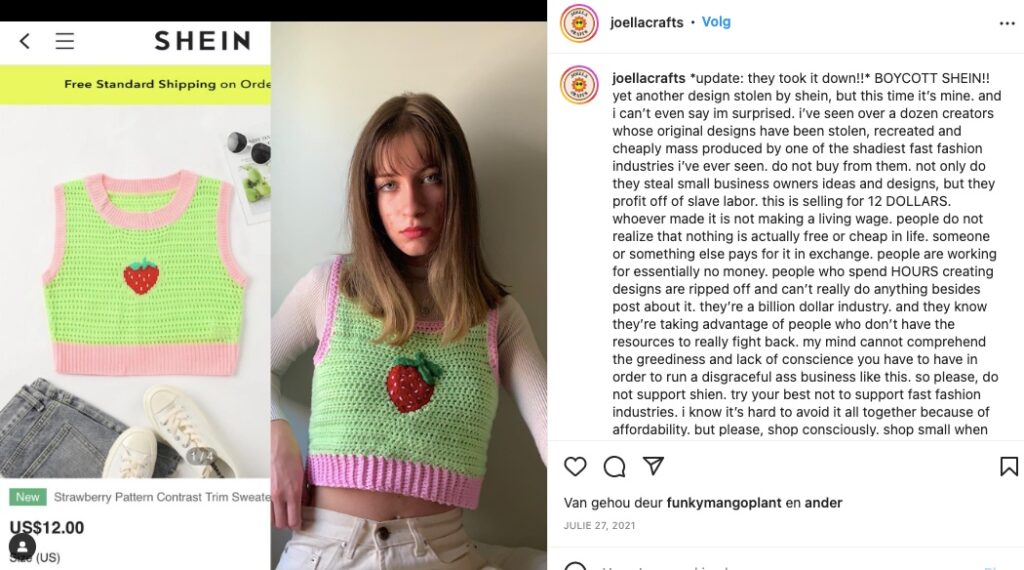
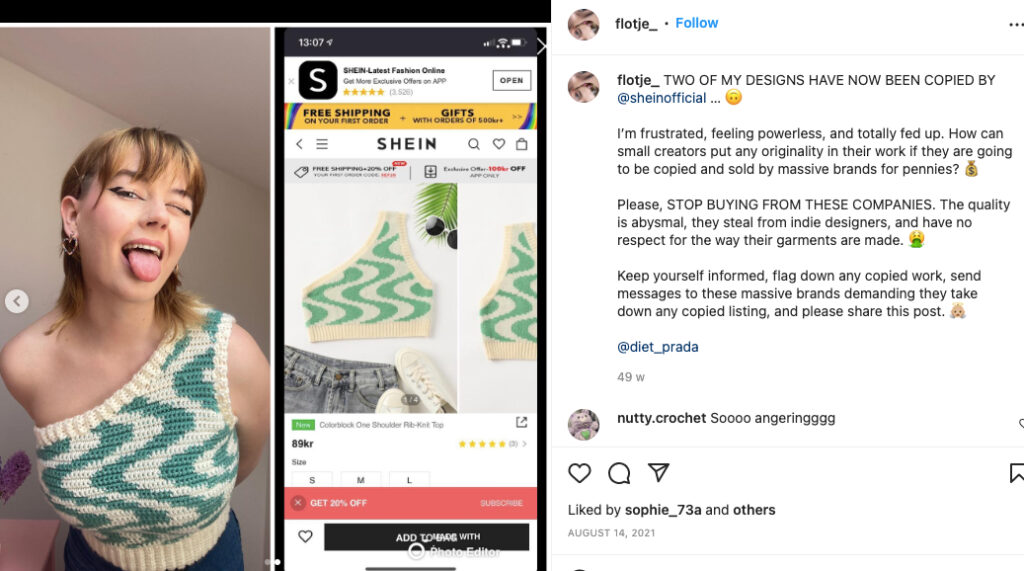
Plagiarism already shows tone-deafness and a lack of sensitivity, but in 2020, they also got into trouble after selling offensive designs. They sold a Muslim prayer mat as a “frilled Greek carpet” and a week later, they were selling a golden necklace with a swastika symbol.
#6. They are not transparent about their supply chain
It’s very difficult to find information about Shein’s supply chain. I now know a big portion of their garments is made in South China, but where do they source the fabrics? Where are the clothes distributed from? Which other countries do they produce in? On their website, they just say the products are ‘sourced from different regions around the world, including China and the US’. They also mention their ‘global supply chain includes material suppliers, manufacturing partners and finished product vendors’. This last one is interesting because it means they also buy finished products from suppliers and they don’t only produce their own designs. This might explain their stealing behaviour as they don’t seem to have full control over their supply chain and just sell whatever they find without checking if the designs are original.
Shein doesn’t just produce their garments in their own factories or suppliers. They also rely on sub-contractors. According to Public Eye, Shein posts production requirements for different designs on the Chinese platform WeChat, and manufacturers can then apply for the production. After receiving an application from a factory, Shein refers them to the fabric supplier where they purchase the fabric and they can start producing the designs. This way, Shein doesn’t have to feel responsible for the working conditions in all these different factories. If something goes wrong in one of the factories or if there are illegal working conditions, Shein doesn’t care because they are not their own factories or main suppliers. It’s unclear whether Shein monitors any of these companies and performs audits. According to Chinese media reports, Shein works with more sub-contractors from WeChat, than main suppliers. So it’s not just done as an extra, it seems sub-contractors produce most of the garments.
They have a Code of Conduct on their website which is full of promises that don’t align with the information I found. I’m probably going to dissect this so-called ‘Code of Conduct’ in a separate article. Some of the things they claim are that workers receive fair living wages and benefits, and that they try their best to source ethical fabrics like recycled materials, but they don’t provide any solid information. There is no way to confirm any of these claims are true.
Shein doesn’t show any transparency. As consumers, we should know exactly where our clothes come from and how they were made. We should be able to hold brands accountable and demand transparency.
Conclusion
Shein wants you to believe clothes are worth the same as disposable and single-use food packaging. Truth is, many hours go into the production of a garment. I’m not just talking about the sewing. I’m talking about all the production steps from designing to the manufacturing of the raw material, making the fabric, sewing the garment, and many more steps after that. And many resources are used and many materials are not biodegradable. Brands like Shein have made people think it barely costs any money to make a garment. The consequence of this is that small businesses who have their designs stolen, receive comments below their posts saying “your clothes are too expensive”. Everything is now compared to Shein’s prices and anything above that is considered ‘expensive’. People have gotten used to seeing a dress for $11, but the only way a price like that can be reached, is if the brand exploits the workers who make it.
In conclusion: Shein is a big contributor to the issue of textile waste and global warming, and they are exploiting the workers so they can offer unrealistically low prices.
I know it can be tempting to scroll through their website and see all those trendy pieces, but believe me, once you start being familiar with the impact brands like this have on the planet, you won’t be tempted anymore. You’ll get physically sick seeing all this junk being produced daily only to be tossed away again after one season because it’s either not trendy anymore, or because the quality is so bad that it doesn’t last longer than that.
Do you want to stop wearing fast fashion, but don’t know any brands who do a better job at protecting their workers and the planet? You can find sustainable brands all over the world on this brand list!
Sources
Banerjee, A., & Dutta, P. (2022, July 19). hein – How the Company Brings Trendsetting Fashion that Stands Out? Retrieved from StartupTalky: https://startuptalky.com/shein-success-story/
de Ferrer, M. (2021, September 9). How are Shein hauls making our planet unlivable? Retrieved from Euronews: https://www.euronews.com/green/2021/09/08/how-are-shein-hauls-making-our-planet-unlivable
Rani, M. (2021, January 24). Chris Xu: Founder & CEO Of Shein. Retrieved from StartupTalky: https://startuptalky.com/chris-xu-founder-shein/
Fressynet, I. (2022, April 5). An inside look at Shein: The $100 billion fast fashion brand where factory staff work 75-hour weeks. Retrieved from Euronews: https://www.euronews.com/green/2022/04/05/welcome-to-the-dark-side-shein-is-the-biggest-rip-off-since-fast-fashion-was-born
Cherrett, N., Barrett, J., Clemett, A., Chadwick, M., & Chadwick, M. J. (2005). Ecological Footprint and Water Analysis of Cotton, Hemp and Polyester. Stockholm Environment Istitute, BioRegional Development Group and WWF Cymru. Stockholm: Stockholm Environment Istitute.
Kollbrunner, T. (2021, November). Toiling away for Shein. Retrieved from Public Eye: https://stories.publiceye.ch/en/shein/
Gan, J. (2021, July 14). Here’s Why You Should Never Shop at Shein No Matter What. Retrieved from Medium: https://medium.com/age-of-awareness/heres-why-you-should-never-shop-at-shein-no-matter-what-8140d285cf4b
Kim, I. A., & Kupelian, K. (2021, July 26). Chinese e-commerce giant Shein has become a $15 billion company. Here’s how it gets consumers to keep spending. Retrieved from Insider: https://www.insider.com/how-shein-gets-consumers-spend-fast-fashion-ecommerce-chinese-company-2021-6
Lal, K. (2021, December 29). How Shein got away with daylight robbery in 2021. Retrieved from Dazed: https://www.dazeddigital.com/fashion/article/55146/1/shein-fast-fashion-exploitation-plagiarism-independent-designers-copy-aliexpress
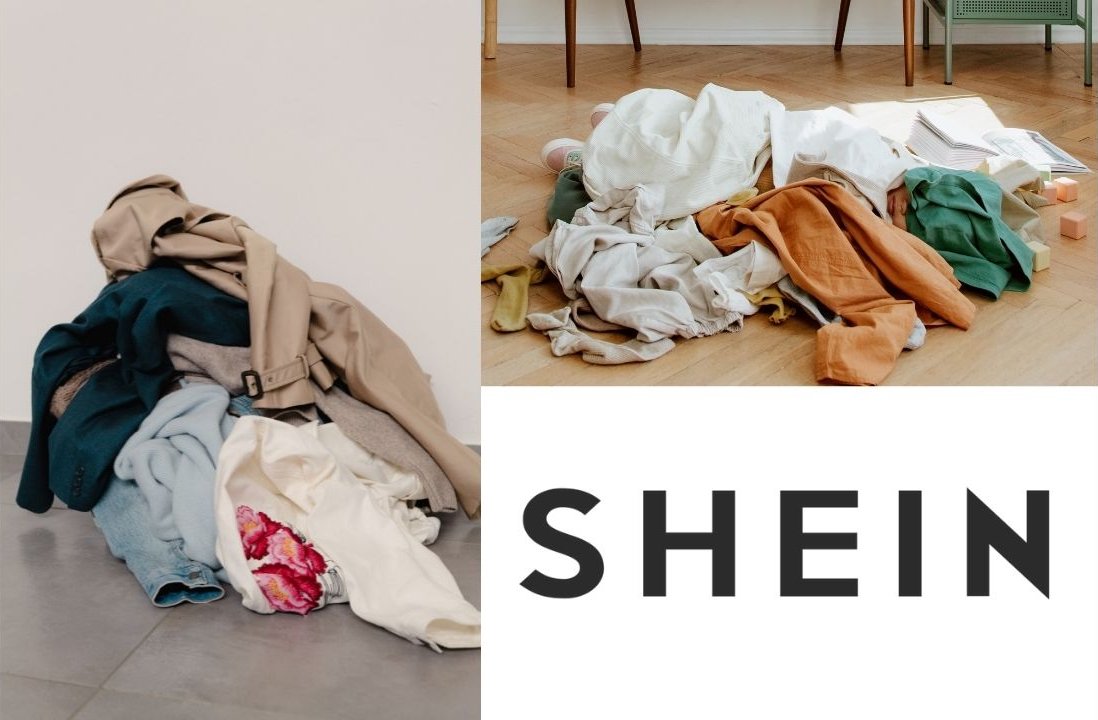

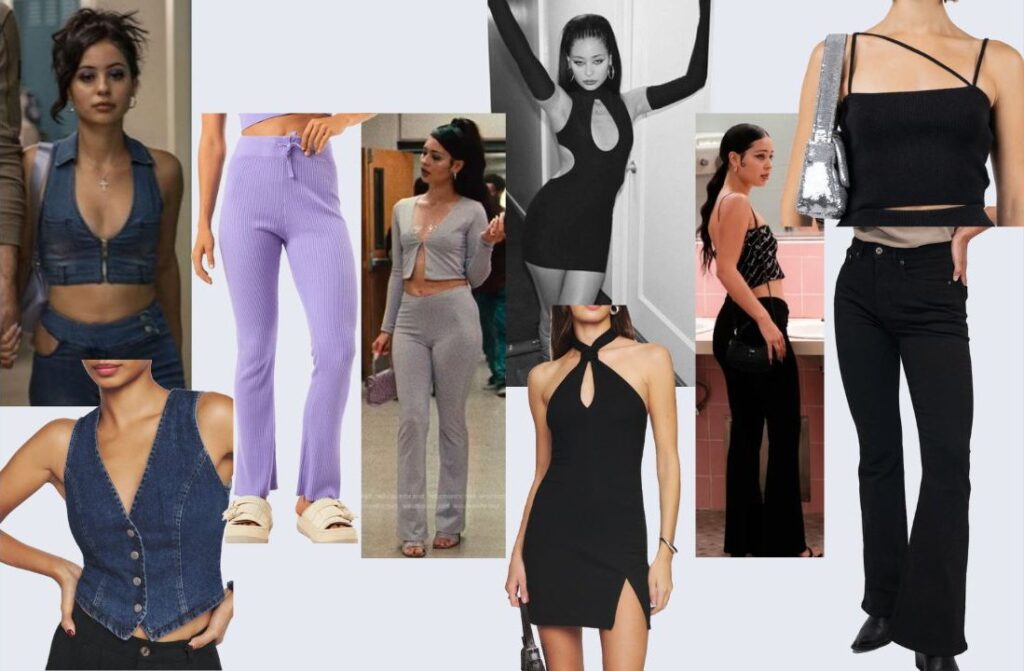
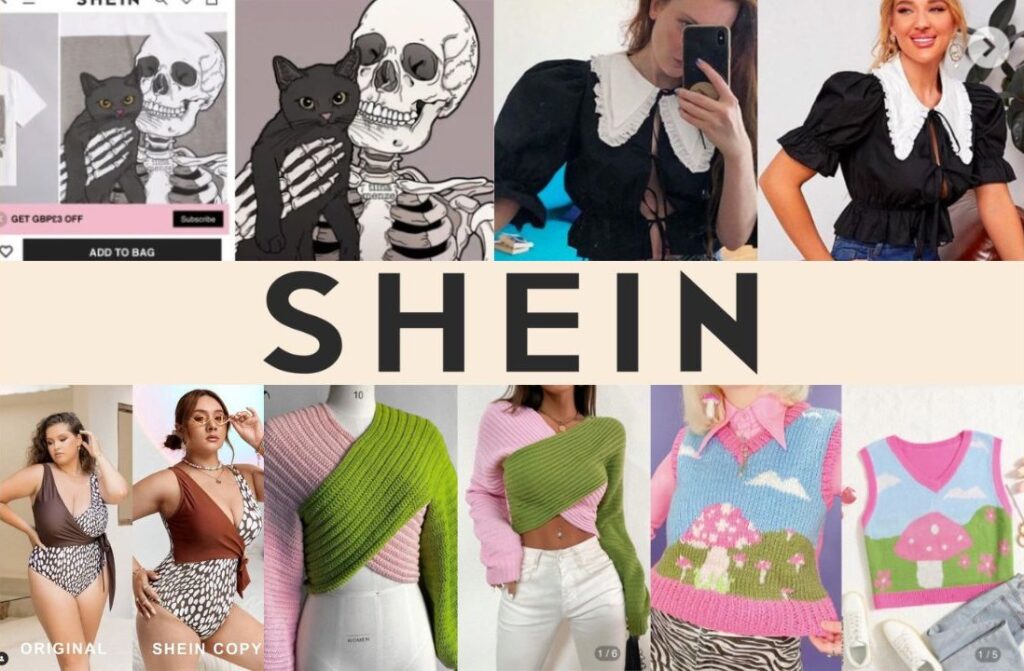
47 thoughts on “6 Reasons You Should Never Shop At Shein”
Was just about to do a haul from Shein and decided to google if I should buy from them. thanks
So glad you found the post just in time haha 😉 thanks for leaving a comment!
Was bout to get new stuff from SheIn when I remembered hearing something about it being bad and researched found this thank god I just feel bad cause i know even if I stop bying it won’t make that much of a difference but even if it isn’t that much I still won’t cause if everyone said well I’m only one person I won’t make a difference then no one will ever realize the danger of fast fashion and we won’t ever make a change.
Yes, I love this mindset! Change starts with yourself. Everything we do individually, impacts the rest of the world in some way. Even making small changes in your own life can already help, and then we can also inspire others around us
I was ordering a skirt set and a brown pant set the top was long . I never received the skirt and never received the the top to wearing my pants. SHEIN robbed me
Yes, I’ve been hearing this a lot too! I guess I could also add this issue to the list..
I’m currently writing an investigative report for one of my college classes on this topic and your article has given me so much good information thank you. Although I am guilty of buying things from their website in the past lol
Such an interesting and important topic to write a report about! Would love to hear about the results. And I get it haha, it’s hard to resist such affordable fashion
THANK YOU SO MUCH!!!! I was about to order from Shein, but felt that something was wrong with them. So, i decided to invèstigate them. I AM SO-O GLAD I DID!!!!! Yes I would love to pay the prices they charge (I don’t have a lot of money) but, I WILL NOT TAKE MONEY FROM OTHERS POCKETS to suit myself! Also, I will not knowingly harm the earth in any way!!! So THANKS for opening my eyes and waking me up to what is REALLY gonig on!!!!
Hi! Wow, thanks for sharing! It’s really admirable that you choose to make a conscious decision, rather than simply give in to the low prices
I have never and shall never buy from them. I worked for a specialty store and everything came from China, Korea, Vietnam, etc. It is so sad that greed has taken over the world and that sweat shops are still existing and others are robbed of their work. I had no idea how this affected the weather and many hard working people. Keep fighting this and forget the 5.
I was doing a discussion post about Shein and I saw this blog. Totally agree with every single point here. It is so powerful and I really really love it. Thank you so much!
Glad you enjoyed reading it! Thanks for leaving a comment 🙂
hi! thank you for this informative post!
do you know if there are any websites where it’s possible to find the source of their products? (as in find the shops/small businesses they stole the designs from, as to purchase items from the actual designer)
Hi, thanks for reading. That’s an interesting question and it would be nice to support those smaller designers and businesses! As far as I know, there isn’t any website like that, so you’ll just have to find the original designs by searching online. Maybe I can make a separate post with a list of all the designers and businesses and keep it updated every time it happens again
Hi. I agree with some of what you’re saying, with the general outline. However, you do tend to carry it a tad overboard. To say that one polyester dress has the same value as the next polyester dress is a bit ridiculous!! Thats obviously not the case! Also, while I agree in theory it would be ideal if we could all shop at eco-friendly stores & wear eco-sustainable clothing…help & give back to our world instead of just take from her right? But we aren’t there yet & I, myself at least, am not living in the clouds! There are people that live WAY below the poverty level & can’t afford 1 shirt, much less the several in every color you mention! So who are you to be so high & mighty & tell people that they don’t deserve that 1 shirt because they can afford the $5?? And the shipping is only $3-4. Some don’t have the money to shop at these eco-friendly stores where you so blithely said “well yeah, it costs more”. Yes, it does. Not everyone has that “more”!! So jump down off your moral high ground & roll around in the mud with us lowly beasts for a minute & maybe get see others perspective before you speak so condescendingly. Thank you.
Hi Heather, I’m sorry to see you didn’t enjoy reading this post. I’ll give my point of view on the topics you mentioned, but it’s okay if you still disagree because you can’t possibly agree with everyone in the world. Okay so: 1. With the polyester dress example, I just meant to say that Shein sells products for lower than the real value. Polyester has a market price and a certain value but Shein cuts down hugely on things like workers’ wages to get to their low prices. So their prices don’t reflect the actual value of the materials used (and also the environmental costs, so the impact on the earth). 2. The people who live below the poverty level and people who can’t afford to switch all their shopping to sustainable brands (myself included, so looks like we are both lowly beasts rolling around in the mud!) are not the problem. Their ecological footprint is not that big because they generally only buy small amounts of new items when it’s necessary and they also shop a lot secondhand and tend to use their clothes for longer. So they don’t have a big impact on the environment. The people who keep the fast fashion industry growing and thriving are the ones that spend hundreds at once and buy a new wardrobe every season. They are the ones that contribute the most to the polluting fashion industry. With this post, I’m hoping to reach those people + the people who do have the financial means to afford more sustainable alternatives every once in a while but just don’t know the harms of fast fashion yet.
I hope this makes more sense. I tried to not make the reply too long haha. Let me know if you want to chat more about this!
I’m wondering what about all the other items sold by them like furniture, stationery, jewelry etc.
The China Malls stock similar items pretty cheap and of poor quality.
That was a bit harsh.
And all those low paid workers if they would rather have no wage at all? There are many facets to the problem.
Wow…..Did you miss the point or what?
hi! I was about to buy over 20 expensive items from shien… costing over 300 pounds (I live in the UK) but when I read your post, I had second thoughts. This has moved me in a personal way as I have not thought of fast fashion in this way before. I read it over and over and went straight back to SHIEN and deleted my entire shopping cart. Thank you so much, this post was very useful to me. I look forward to be reading about more fast-fashion on this lovely, thoughtful website!
Aw wow! I’m glad you felt inspired by the post. I’m planning to write more about fast fashion in the next few months so I hope you’ll stick around 🙂 Thanks for reading!
I used to be recommended this website by means of my cousin. I am no longer sure whether this post
is written by means of him as nobody else recognize such
distinct approximately my difficulty. You are wonderful! Thank you!
Love SHEIN great cloth and prices
Was thinking about buying from Shein but this convinced me not to. Great article and thank you for including sources 🙂
Glad you enjoyed reading it!
What a load of garbage. There’s going to be issues with buying clothing and products across the spectrum of pricing. Do you share the same level of apparent awareness across all caveats of life like your eating, transport and electrical costs? I’m sure the laptop you’ve written this on has a negative impact on the earth…get off your moral high horse. Unless you go back to living like a cave man a small change to the way you shop for clothes is not going to make an impact on the world
Hi Anita, sorry for not getting back to your comment sooner. I was taking a little break. Anyway, I think one of the most beautiful things about people is that we all have different opinions, norms and values. For me, I value and prioritise the environment and try to implement sustainability in every aspect in my life, so yes, also in food, transport etc. It seems that you have different values and opinions. Sustainability is not at the top of your list and that’s fine. If you still want to continue shopping at Shein after reading this article, then you are free to do so. We can all make our own decisions.
Also, switching from fast fashion to more conscious clothes is not a small change at all. The fashion industry is one of the most polluting industries, so making a change in the way you dress is a really big deal.
The only Shien item I own I bought on a second hand website called threw up and it was in good condition. I buy items second hand often as long as they are in good condition. Often at thrift stores you can even find brand new items. I do this because I have seen the dumps filled with clothing that ends up in places like Africa from the worlds fast fashion clothing that gets discarded. It is an awful impact on the environment. Reduce, recycle and reuse is a good motto for us all. Yes I do buy new things but only from brands that can be trusted to be ethical.
Thank you for adding this comment. That is a good point. Buying items secondhand from fast fashion brands is really good! We need to keep them out of landfill as long as possible.
I just received 2 light jackets and the zippers are broken. I want to return them and receive a refund. I contacted customer service and was referred to a website called Howly. They want me to pay $10.00 to talk to them. All I want is a proper address to return the merchandise. Sounds borderline illegal to me. Shame on them! Live and learn.
Thank goodness I read this; I’ve not ordered but found a piece at the goodwill that I will donate because not sure what to do with it.
Thanks for leaving a comment! Just wanted to add it’s okay to get SHEIN items from Goodwill or other thrift stores, because it’s good to keep secondhand clothes in use for as long as possible, so they don’t end up in the garbage dumps
Ordered from them even though I knew it is cheaply made clothing just wanted to wear for a week vacation. Never received my package it was delivered to wrong address by FedEx who told me Shein would be able to process a delivery problem request with them but that ultimately Shein would either refund me or process a new order and to contact them. There is no way to contact a live person. I started using a consumer complaint service and have only received emails stating that they are working on it!! I placed my order in April and still have not received a refund!! Now I see not only do they have horrible customer service but the company itself is horrible! So sorry I ever ordered from this terrible company
I ordered two orders from shein July 5th and July 28th. I have not received either one of them. The one from July 5th says it was delivered to my address. I emailed them and they cannot give me an answer of how it was shipped or a postal tracking number. They emailed the tracking number that does not match any shipping company. They keep telling me to check with my neighbors. I have done that and nobody has seen the package. If it is a scam to get mine and other people’s money then shame on them. I will not be ordering again.
That’s terrible!
Hi! I just wanted to tell you how I appreciate how you respond to the comments on more of the rude side. Like whenever people say rude things about you and what you have said you do not immediately give them rudeness back, you take a minute to look through their side of the story or their point of view on things and respond from a non-biased opinion. Comming from someone who has dealt with people opposite from this makes me really appreciative of you.
Thank You!
Aw thank you so much! I really appreciate your comment. I do always try to think about those comments for a few days before responding. I also think they actually inspire me for future articles, because it makes me better understand how others view sustainable fashion. I think it helps my writing if I try to relate to them and see where they are coming from.
Received an order of clothing from Shein, ended up taking the lot to the local thrift store. A blouse had one sleeve longer than the other and all the garments had a strange odor. These clothes did not resemble their pictures at all.
Just out of curiosity since I’m kinda broke, but do you have any good alternatives?
Hi, thanks for this question! It’s actually giving me some inspiration for a new article. You won’t find any sustainable brand that has similar prices to fast-fashion brands like SHEIN. I don’t know where in the world you live, but here are some examples of ethical brands -> In America: Kotn, ABLE and CHNGE. In Europe: Armedangels, Honest Basics and Nu-in. Australia & NZ: Afends, Kowtow and Nobody Denim. Again, their prices are much higher than SHEIN’s. But the most important thing is actually your behaviour towards clothes. If you have to occasionally buy things from fast-fashion brands because you really need something and you can’t afford a sustainable option, that’s fine. You can already make a positive impact by changing things like: don’t buy excessive amounts, be aware of what you already own, only go to fast-fashion brands as a last resort, shop from local companies so don’t order from places on the other side of the world, take care of your clothes so they last longer, don’t throw clothes away if you don’t want them anymore but sell or donate instead. You can also organise clothing swaps with friends, and of course thrift. You can find secondhand clothes either in local shops, or on websites like Vinted, thredUP, Poshmark and Depop. Also, a lot of sustainable brands offer sales sometimes, so you can keep an eye on that. I share a lot of sustainable brands on this website, and also (more frequently) on Instagram (@ethicallydressed). Apologies for the long response..
I’ve ordered from Shein once, and I ended in less than a year donating most of the garments to a recycling center. People must be aware that they don’t only produce sub par clothing,but are also misleading on the materials of garments, they advertise in some of them cotton blended with polyester and you might end getting garments made 100% rayon, not to mention the amount of plastic used for packaging.
Thanks for the post. I wish I had read it earlier.
Hey love the post. But I’m a writer and you needed a few counterclaims to be a little bigger and take a walk in another person’s shoes! I love your passion though this is a great ? article it helped a lot and I now know the pros and cons about SHEIN! Sorry if this sounds like I’m judgy not trying to be ?thank you!
Hi Jane, thank you for your comment. I didn’t read it as judgy at all so no worries! I always appreciate feedback and suggestions. I’m definitely not a writer myself, just passionate about the textile industry and sustainable fashion. I think there is still a lot of room for improvement for me when it comes to writing, and maybe it’s time to give this article a little update as it’s been two years since I wrote it
I am concerned about an order I placed back in June- received 2 items and the other 3 were said to be shipped separately. No tracking updates since June 24th- no reassurance that I will receive the items. Contacting customer service- no luck- only automated responses. I will probably never use Stein again
I’m a personal stylist and I CANNOT STAND it when my clients go rogue and shop at SHEIN or the other Uber fast fashion brands. Buy less, purchase investment pieces, keep things longer, and do your research before shopping! The sad news is that the vast majority of brands, including designer brands are not doing what should be done from a sustainability perspective! But SHEIN is the worst of all!